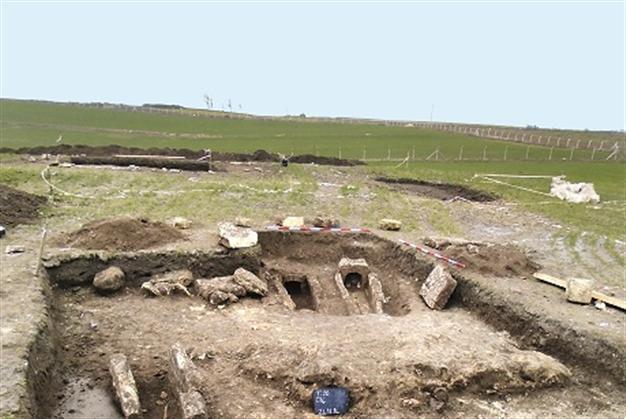Wind power plant to be built on archaeological site in Istanbul's Silivri
Ömer Erbil - ISTANBUL

Turkey’s Cultural and Natural Heritage Preservation Board has refused to declare a plot of land in Istanbul’s Silivri district as a first-degree archaeological site despite the discovery of artifacts from the Hellenistic, Roman and Byzantine eras. Now, the artifacts face an even greater threat as a wind-power company has indicated that it wants to cover the findings and continue constructing 21 wind turbines.

Historical artifacts were discovered during the construction of Silivri Energy A.Ş.’s wind power plant belonging to businessman Abdullah Tivnikli in the village last February.
Among the artifacts were many Hellenistic- and Roman-era tombs and one-meter walls. After the protection board failed to declare the area a first-degree archaeological site, the company reportedly suggested to the board: “We cannot protect the field against treasure hunters. Let’s pour concrete on it and build wind turbines on it.”
The suggestion provoked a heated discussion on the preservation board, with only Dr. Aslıhan Yurtsever Beyazıt speaking out against the proposal. While other members recommended documenting the findings before pouring concrete on the site, Beyazıt demanded examinations at the site, but no investigation has yet been conducted.
On June 15, 2011, the Istanbul Metropolitan Municipality made amendments to its master plan for the construction of the wind power plant close to Silivri’s Fener, Kurfallı and Akören villages. The amendment was approved by the Istanbul Municipal Council in 2012.
A decision was subsequently made to build 21 52.5 MW turbines on an area of 440,000 square meters. The company started the construction last year, while the archaeological artifacts were found on the land of two turbines at the beginning of this year.
The Istanbul Archaeology Museum was informed about the artifacts, and further excavations by museum officials unearthed valuable architectural remains dating back to the late Byzantine era in the 11th and 12th century A.D.
The presence of many Byzantine-era tombs in the immediate vicinity suggests there could be a monastery in the area, according to officials. “This is a very important development for Thrace and Istanbul archaeology. It should be declared a first-degree archaeological site immediately,” one of the officials said.
“Since brick pieces were not found in the remains of the wall and a roughhewn stone was seen, it might be a Roman-era settlement,” the Istanbul Archaeology Museum said in a statement. “The remains of a structure, which is made up of big block stones, is thought to have been a wall from the Hellenistic era. The area might have been a Hellenistic and Roman settlement because the ceramic pieces around this structure show Hellenistic and Roman-era characteristics. The area might have served as a graveyard in the Byzantine era.”
 Turkey’s Cultural and Natural Heritage Preservation Board has refused to declare a plot of land in Istanbul’s Silivri district as a first-degree archaeological site despite the discovery of artifacts from the Hellenistic, Roman and Byzantine eras. Now, the artifacts face an even greater threat as a wind-power company has indicated that it wants to cover the findings and continue constructing 21 wind turbines.
Turkey’s Cultural and Natural Heritage Preservation Board has refused to declare a plot of land in Istanbul’s Silivri district as a first-degree archaeological site despite the discovery of artifacts from the Hellenistic, Roman and Byzantine eras. Now, the artifacts face an even greater threat as a wind-power company has indicated that it wants to cover the findings and continue constructing 21 wind turbines.  Historical artifacts were discovered during the construction of Silivri Energy A.Ş.’s wind power plant belonging to businessman Abdullah Tivnikli in the village last February.
Historical artifacts were discovered during the construction of Silivri Energy A.Ş.’s wind power plant belonging to businessman Abdullah Tivnikli in the village last February. 